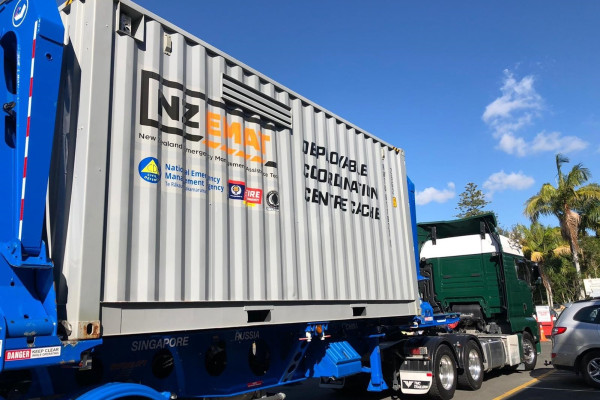Logistics and equipment
Learn more about how the New Zealand Emergency Management Assistance Team operates and what deployable capability is available with the Team.
- How does the New Zealand Emergency Management Assistance Team work?
- Deployable Coordination Centre (DCC) caches
How does the New Zealand Emergency Management Assistance Team work?
The EMAT cadre is drawn from personnel working in a wide range of qualifying agencies. Qualifying agencies include central and local government agencies, the emergency services and New Zealand Defence Force. These personnel have significant experience in crisis response and emergency management in a range of settings in New Zealand and overseas.
Current EMAT members are drawn from:
- Auckland DHB (1 member)
- Canterbury CDEM (2 member)
- Christchurch City Council (2 members)
- Department of Conservation (2 members)
- Department of Internal Affairs (1 member)
- Emergency Management Bay of Plenty (5 members)
- Emergency Management Otago (1 member)
- Fire and Emergency New Zealand (8 members)
- GNS Science (1 member)
- Hurunui District Council (1 member)
- Manawatū District Council (1 member)
- Ministry of Business, Innovation and Employment (1 members)
- Ministry of Social Development (2 members)
- National Emergency Management Agency (3 member)
- Nelson-Tasman CDEM Group (1 member)
- New Zealand Red Cross (1 member)
- New Zealand Trade & Enterprise (1 member)
- Northland CDEM Group (1 members)
- Pike River Recovery Agency (1 member)
- Statistics New Zealand (1 member)
- St John (2 members)
- Te Puni Kōkiri (2 members)
- Timaru District Council (1 member)
- Wellington Regional Emergency Management Office (1 member)
- West Coast CDEM Group (1 member)
- Whangarei District Council (1 member)
- Whanganui District Council (1 member)
The EMAT cadre is managed day-to-day by the Deployable Capabilities team within the National Emergency Management Agency. In a response, the deployment of team members would be managed by National Emergency Management Agency duty staff or the National Crisis Management Centre, if activated.
EMAT members have comprehensive personal equipment, uniform and PPE, enabling them to deploy and operate effectively after a severe emergency.
Deployable Coordination Centre (DCC) caches
CDEM Groups, and other lead agencies, can request a Deployable Coordination Centre (DCC). Fire and Emergency New Zealand Urban Search & Rescue have developed and maintain five DCCs on behalf of NEMA and EMAT.
Deployable Coordination Centre (DCC) one-pager.pdf
Each DCC is a 20ft ‘high top’ side-opening shipping container, which is equipped with lights and power outlets, and serves as a responder briefing point and equipment maintenance area.

Each DCC can be rapidly deployed using 20ft deck Hi-Ab prime movers or side-loading 40ft semi-articulated trucks.
The container holds a wide range of equipment sufficient to establish a fully equipped 50-person coordination centre. This can be used at local or regional level and could also support incident ground activity.
The core element of the DCC are three rapidly erected, multi-purpose Covertex AirShelters. These are inter-operable with other units used by a wide range of agencies including New Zealand Defence Force, the New Zealand Medical Assistance Team, New Zealand Red Cross, eight CDEM Groups, St John and Auckland airport.

High level contents
Each DCC provides 156m2 of weatherproof heated habitation complete with:
- Two 6x9m insulated 4-door Covertex AirShelters each 54m2
- One 6x6m insulated 2-door Covertex AirShelter 36m2
- 24 tables
- 48 chairs
- Two Covertex entry vestibules circa 6m2
- High volume diesel forced air heater system.
- 7.5kw and two 2kw petrol inverter generators
- Internal and external low voltage low wattage LED lighting
- Coordinated Incident Management System teardrop flags for functional areas.
- 69 colour-coded CIMS vests covering all functions, including recovery and Iwi Representation
- Comprehensive stationery supplies including desk items, A3 laminator, guillotine, A3 printer.
- Data projector and screen
- 2 portable battery and mains powered PA systems to support briefings and community meetings.
- 4 wharepaku tents and commodes, and waste management system sufficient for the first 72hrs
- Basic gas cooking sets to provide hotwater for drinks and ration pack reheating.
- Basic equipment maintenance, handtools, 18v powertools and minor repair equipment. These are intended to ensure a DCC can continue to operate for several months in an austere post disaster environment or effect minor repairs to existing facilities.

